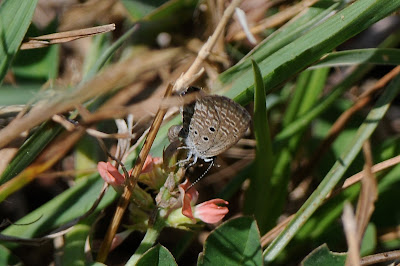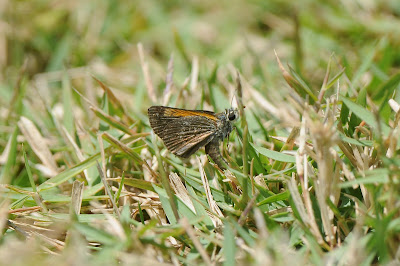Strap your helmets on for some crazy bfly action from Florida! Ok, so not so crazy but it's true that I recently spent some time in Florida looking for birds and butterflies. This post is devoted to some of the butterflies I managed to bump into along the way....
Starting with swallowtails, this butterfly was in a dark and shaded hammock in the Everglades National Park. I believe the underside of this butterfly gives the identity of a PALAMEDES SWALLOWTAIL:
The only whites I saw on the trip were GREAT SOUTHERN WHITES... or at least I think that's what they were. I was keeping a lookout for a Florida White but couldn't convince myself that any of these were that species. Maybe you could?

Easily one of the most noticeable species was the giant (and fairly common) LARGE ORANGE SULPHUR. This one was at Key West:
Much less flashy was this new species for me, the BARRED YELLOW:
I tried to make these blues into one of the south Florida specialties like Nickerbean or Miami blue but I'm fairly certain they are just CERAUNUS BLUES:
There were plenty of "milkweed butterflies" throughout the trip and I'm starting to think that I don't have a clue what is going on with them. For example, are all 3 of these QUEENS? I see some black veining on the first butterfly (two photos) that might suggest a SOLDIER but I'm not convinced:

Another abundant butterfly in Florida is the striking WHITE PEACOCK:
I was very pleased to finally stumble on a RUDDY DAGGERWING at Loxahatchee NWR:
We didn't see very many anglewings on the trip, in fact, the only one was this QUESTION MARK in northeast Missouri:
I was keen to find my first Mangrove Buckeye but I think my one-and-only buckeye on the trip was a COMMON BUCKEYE:
One of the flashiest butterflies down south is the ZEBRA HELICONIAN and for good reason, it's downright attractive:
This spread-wing skipper we found in the Keys is unsurprisingly giving me issues. I think it's a worn duskywing, perhaps ZARUCCO:
One of the few butterflies I knew right away was the EASTERN PYGMY-BLUE which ended up being common at the salt flats we visited in the Keys. For example, this photo is of one on the car hood!
Since Marine Blues don't occur in south Florida, I suspect these are CASSIUS BLUES:
This large and dark skipper had me puzzled at first. Given that I noticed the huge size of this butterfly instantly at the time, I thought it could be a Palatka Skipper. However, it was then I found MONK SKIPPER in the book and that "clicks" a lot more:

Here is a very problematic butterfly that we found in Flamingo. At the time, it was a noticeably large and fast skipper. However, I'm truly clueless what it could be. Maybe a chewed-on DORANTES LONGTAIL? That would explain the size, at least. Any input would be very helpful!
It wasn't long in Florida that I started seeing BARACOA SKIPPERS just about everywhere. Grassy lawns, campgrounds, etc. Thankfully, I caught up to a couple:

We found ourselves in saltmarsh habitats many times which explains our uncanny ability to find the SALT MARSH SKIPPER:

While we're on the topic of skippers in salt marshes, this skipper was in a salt marsh in eastern Virginia. Is it a SWARTHY SKIPPER, RARE SKIPPER, or maybe just a TAWNY-EDGED SKIPPER?

Ashley spotted this tiny skipper while we were in Flamingo, Florida. I'm cautiously optimistic that this is a THREE-SPOTTED SKIPPER instead of the common Eufala Skipper. Thoughts?

Last but not least, we found this large and striking skipper in northeastern Missouri, the HOBOMOK SKIPPER:

That's all for now. Stay tuned for another post on this blog regarding other insects I'm successfully trying to identify.


























No comments:
Post a Comment